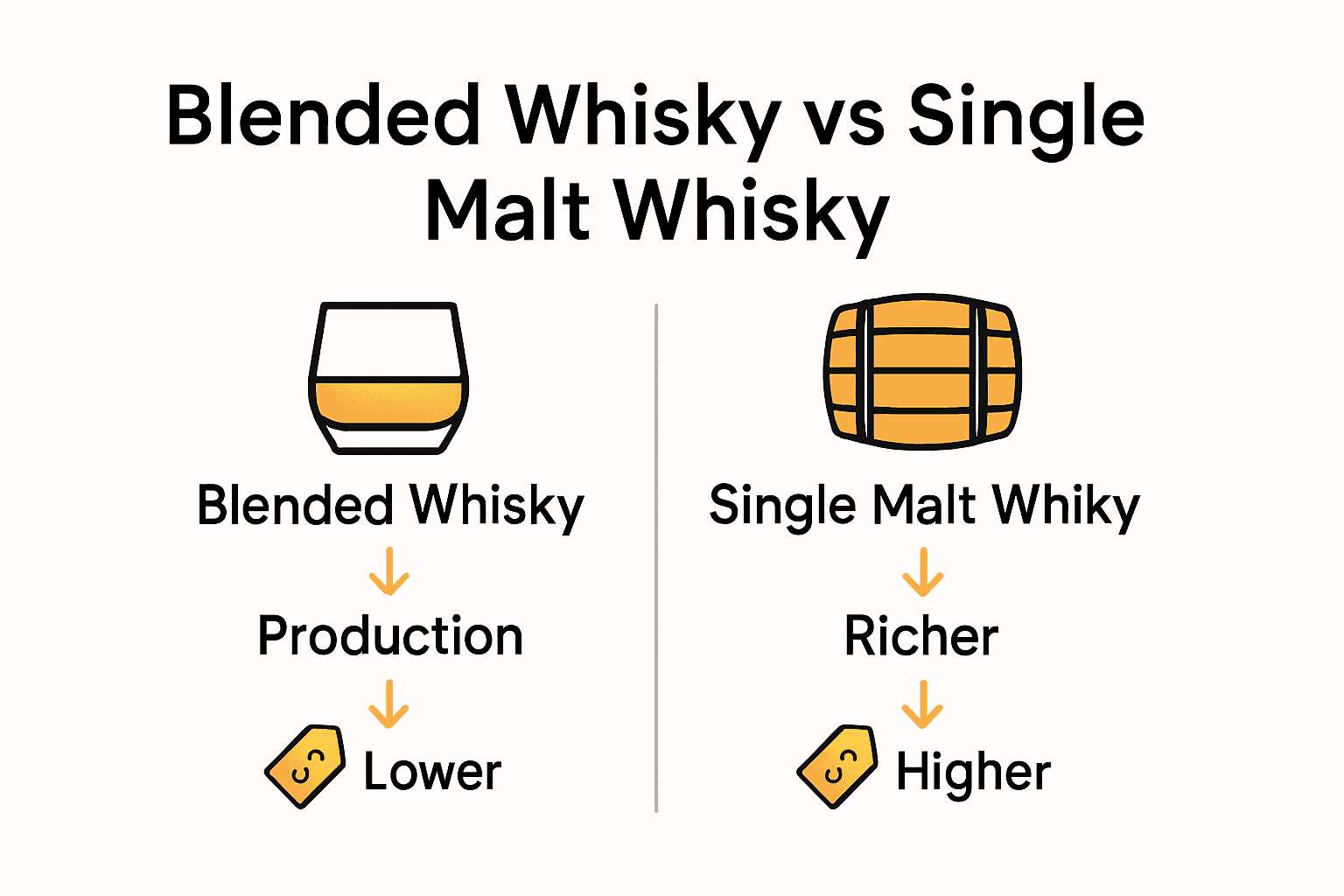Most people are surprised to learn that over 90 percent of whisky enjoyed worldwide is blended, not single malt. For australian whisky fans, separating fact from fiction about blended whisky matters more than ever because choice keeps growing and so do the myths. This guide breaks down what truly defines blended whisky, uncovers common misconceptions, and helps you appreciate the skill behind every expertly crafted australian blend.
Table of Contents
- Defining Blended Whisky And Common Myths
- Types Of Blended Whisky Worldwide
- How Blended Whisky Is Made
- Unique Characteristics And Flavour Profiles
- Blended Whisky Versus Single Malt Whisky
Key Takeaways
| Point | Details |
|---|---|
| Blended whisky sophistication | Blended whisky combines various styles to create a nuanced drinking experience, challenging the myth of inferiority compared to single malts. |
| Global diversity | Various regions produce distinct types of blended whisky, each reflecting unique cultural practices and flavour profiles. |
| Intricate blending process | The blending of malt and grain whiskies is an art that requires skilled mastery, focusing on consistency and complexity. |
| Contrasting styles | Blended whiskies offer versatility and affordability, while single malts provide individualistic, regional characteristics often at higher prices. |
Defining Blended Whisky and Common Myths
Blended whisky represents a sophisticated artform of distilling that combines multiple whisky styles to create a harmonious and balanced drinking experience. According to ijarsct, blended whisky is technically a combination of different types of whiskies, typically featuring a mix of malt and grain whiskies carefully crafted to achieve a consistent flavor profile.
Contrary to popular misconceptions, blended whisky is not an inferior product but rather a nuanced expression of the distiller’s skill. As research from iard highlights, blended whiskies often offer remarkable complexity by combining whiskies from different distilleries to create a product with unique taste and character.
The blending process involves several key characteristics:
- Mixing malt whiskies (made from 100% malted barley)
- Incorporating grain whiskies for smoothness and balance
- Creating a consistent flavor profile across batches
- Showcasing the blender’s expert palate and craftsmanship
While single malt enthusiasts might argue for pure expressions, blended whiskies demonstrate remarkable versatility. Expert blenders carefully select and combine whiskies to produce a final product that can be more complex and interesting than its individual components. The goal is not just consistency, but creating a symphony of flavors that tells a unique story in every sip.
Types of Blended Whisky Worldwide
Blended whiskies represent a global tradition of craftsmanship, with each region offering unique expressions of this beloved spirit. According to ijarsct, blended whiskies are produced worldwide, featuring remarkable diversity across several key regions including Scotch, Irish, American, Canadian, Japanese, and Indian styles.
The regional variations in blended whisky production reflect profound cultural and historical traditions. As documented by iard, each geographical area adheres to specific regulations and production methods that profoundly influence the final product’s character.
Key global blended whisky types include:
- Scotch Blended Whisky: Combines malt and grain whiskies from Scotland, known for complex, smoky profiles
- Irish Blended Whisky: Typically smoother and lighter, often triple-distilled for exceptional smoothness
- American Blended Whisky: Combines neutral grain spirits with straight whiskies, creating a distinct flavor
- Canadian Blended Whisky: Famous for exceptionally smooth and light characteristics
- Japanese Blended Whisky: Renowned for precise craftsmanship and elegant, balanced profiles
These regional styles demonstrate how blended whiskies are far more than simple mixtures. They represent intricate expressions of cultural heritage, master blender expertise, and generations of distilling knowledge. Each blend tells a unique story, inviting enthusiasts to explore the rich tapestry of global whisky traditions through a single, carefully crafted glass.

For those eager to dive deeper into whisky varieties, check out our guide to essential whisky types.
How Blended Whisky Is Made
Blended whisky production is a sophisticated art that combines science, skill, and generations of distilling expertise. According to ijarsct, the process involves carefully selecting and combining different malt and grain whiskies to achieve a precise and desired flavor profile, requiring extraordinary expertise from master blenders.
The blending process is intricate and nuanced. As documented by iard, master blenders meticulously mix various malt and grain whiskies from multiple distilleries to create a consistent and balanced product that maintains exceptional quality and taste.
Key steps in blended whisky production include:
- Selecting high-quality malt and grain whiskies from various sources
- Analyzing individual whisky characteristics and flavor profiles
- Carefully measuring and combining different whisky components
- Aging the blend to develop complexity and smoothness
- Conducting rigorous taste tests to ensure consistency
The art of blending requires an exceptional palate and deep understanding of how different whisky styles interact.
Master blenders are like culinary composers, creating harmonious flavor symphonies by understanding the subtle interactions between different whisky types. Each blend represents a unique expression of craftsmanship, balancing tradition with innovation.
Want to explore more about whisky’s rich history? Check out our brief history of whisky to understand how this remarkable spirit has evolved over centuries.
Unique Characteristics and Flavour Profiles
Blended whiskies represent an extraordinary spectrum of sensory experiences, offering enthusiasts a remarkable journey through diverse taste landscapes. According to ijarsct, these whiskies can range from light and smooth to rich and complex, depending on the intricate selection and proportion of malt and grain whiskies used in the blend.
The flavor complexity of blended whisky is a testament to the master blender’s artistry. As documented by iard, the unique characteristics emerge from carefully considered combinations of whisky types, their respective ages, and sophisticated blending techniques that create a diverse spectrum of taste experiences.
Flavor profile categories in blended whisky include:
- Light and Delicate: Soft, gentle notes with minimal smokiness
- Rich and Robust: Intense flavors with deep caramel and spice undertones
- Smoky and Peated: Strong maritime and earthy characteristics
- Smooth and Balanced: Harmonious blend with no single note overwhelming others
- Complex and Layered: Intricate flavor interactions that evolve on the palate
Understanding blended whisky is like appreciating a fine musical composition. Each whisky component acts as an instrument, contributing its unique tone and timbre to create a harmonious final expression. The master blender orchestrates these elements with precision, transforming individual spirits into a symphonic taste experience that tells a rich, nuanced story in every sip.
Want to explore more about whisky varieties? Check out our guide to essential whisky types.
Blended Whisky Versus Single Malt Whisky
The world of whisky is rich with nuanced distinctions, and the debate between blended and single malt whisky represents a fascinating exploration of craftsmanship and flavor. According to ijarsct, the fundamental difference lies in production method: blended whisky combines malt and grain whiskies from different distilleries, while single malt whisky is produced exclusively from malted barley at a single distillery.
Production techniques dramatically shape the character of these spirits. As documented by iard, the blending process allows for consistent flavor profiles, whereas single malt whiskies often showcase more distinctive and individualistic taste characteristics unique to their origin.
Key comparative aspects include:
- Flavor Consistency: Blended whiskies offer predictable taste
- Complexity: Single malts provide more pronounced regional characteristics
- Price Point: Blended whiskies are typically more affordable
- Versatility: Blended whiskies work well in cocktails
- Collector’s Value: Single malts often command higher prices among enthusiasts
Understanding these differences is like appreciating different musical genres.
 Blended whisky is an orchestra, harmoniously combining multiple instruments, while single malt is a virtuoso solo performance - each beautiful in its own right, appealing to different palates and preferences.
Blended whisky is an orchestra, harmoniously combining multiple instruments, while single malt is a virtuoso solo performance - each beautiful in its own right, appealing to different palates and preferences.
For whisky lovers wanting to dive deeper into selection techniques, check out our guide to choosing single malt whisky.
Discover the Art of Blended Whisky with Uisuki
Understanding blended whisky goes beyond just knowing its definition. It is about appreciating the intricate skill of combining malt and grain whiskies to create a consistent and harmonious flavour profile. If you have found yourself curious about how master blenders craft these rich, balanced spirits or want to explore a versatile whisky collection for every occasion you will find exactly what you need at Uisuki.com.au.
Explore the unique world of Scotch blended whisky through our carefully selected range, including exclusive bottles from renowned distilleries like The Balvenie and Glenfiddich. Each blend tells a story of craftsmanship and flavour sophistication, designed to entice both new enthusiasts and seasoned collectors.

Elevate your whisky experience today by visiting Uisuki.com.au where you can browse premium blends, read expert guidance, and enjoy seamless shopping with fast delivery across Australia. Don’t miss your chance to own a masterpiece born from tradition and innovation—start your blended whisky journey now with our exceptional selection of timeless Scotch whiskies.
Frequently Asked Questions
What is blended whisky?
Blended whisky is a sophisticated spirit made by combining multiple whisky styles, typically including both malt and grain whiskies, to create a harmonious and balanced drinking experience.
How is blended whisky different from single malt whisky?
The main difference lies in production: blended whisky combines whiskies from various distilleries, while single malt whisky is produced exclusively from malted barley at a single distillery, resulting in distinct flavour profiles.
What are the key characteristics of blended whisky?
Blended whisky typically features a consistent flavour profile, offers complexity through the combination of different whisky types, and is known for its smoothness and balance created by expert blenders.
Why should I choose blended whisky over single malts?
Blended whiskies often provide greater versatility, making them ideal for cocktails and a wide range of tastes. They are also usually more affordable, offering excellent value without compromising on flavour complexity.

